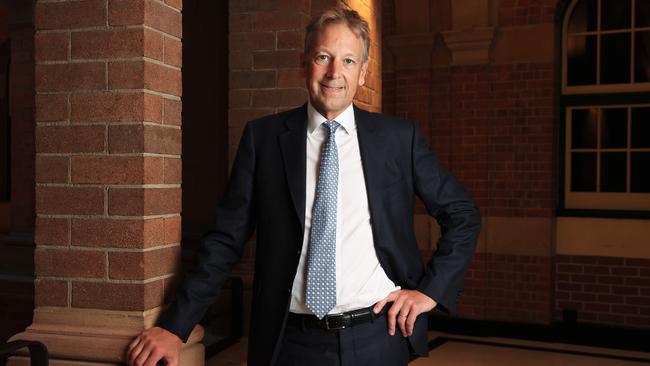
The number – 3 per cent – was a new forecast from Stausholm about the expected annualised production growth in the coming five years across copper, lithium and, importantly, iron ore.
From the outside it might not seem like a big deal, but inside Rio it’s a benchmark. It finally reverses the miner’s nearly decade-old problem of shrinking output from its mix of new and older mines.
Rio Tinto is “never going to be a high-growth company” like a tech company, Stausholm concedes to The Australian. But after production going backwards for years “we will grow around 3 per cent for the next five years. I’m very proud of that now we have profitable growth back in Rio”.
Stausholm delivered Rio’s first half accounts from Sydney, another milestone with the mining boss splitting his official engagements between (mostly) London and Melbourne. On Wednesday the CEO was keen to drum up interest from a broader set of investors.
This time, Stausholm has a story to tell.
Where others like BHP are on the mega-acquisition path or battling crippling losses in nickel, while Fortescue’s is recalibrating its own high-risk green energy ambitions, Rio’s numbers are now telling a story of a consistent and stable miner.
As key iron prices held steady, Rio posted flat underlying earnings of $US5.8bn, and the return on capital employed is a robust 19 per cent. In the June half, Rio posted an interim dividend of $US1.77 a share, steady on the same time a year ago, meaning $US2.9bn will be sent back to investors.
BHP’s aborted move on Anglo American earlier this year means M&A is back in vogue for big miners, particularly in the global chase for top-tier copper deposits.
Stausholm isn’t shy to deals, particularly in his first two years in the job where he paid more than $US3.3bn to clean-up Rio’s fractured ownership of the Oyu Tolgoi mine in Mongolia, the world’s largest known copper and gold deposit. Rio now controls 66 per cent of the deposit, which on the multiples BHP was offering is increasingly looking like a bargain.
Stausholm says he has “absolutely no FOMO” – fear of missing out on a deal. “The key thing for me is, can a deal add value?”
He won’t be drawn on talks Rio is eyeing Canadian copper and zinc miner Teck Resources, with any deal set to be more than $US26bn.
However, he says it’s numbers like the 3 per cent figure he issued Wednesday that has given the one-time accident-prone Rio its licence back to do large buyouts. The miner too had a track record of poor deal making, particularly in the high-priced Alcan deal for more than $US38bn shortly before the global financial crisis, giving it aluminium just as China was about to flood the market with low-cost metal. That deal largely put Rio Tinto out of the M&A game since.
When Stausholm became chief executive in 2021, big investors took the chance to remind him of the much-hated Alcan deal.
“I don’t want to repeat that (deal). It’s known that probably more deals fail rather than gain value. So I’m very careful and selective,” the Rio boss says. “But I also want to say it’s not that we are afraid of deals. If a deal really makes sense, we will go after it.”
Still, he wants the market to know Rio now has growth inside its own business. There’s nearly $US6bn investment on building out the Simandou high-grade iron ore deposit in Guinea. After years of false starts, Oyu Tolgoi is finally ramping up with the target of 500,000 tonnes of copper on track for mid-next decade. Lithium is being progressed in Argentina and Serbia.
The flagship iron ore mine is looking to move up to 360 million tonnes annually over the medium term, compared to the range of 323 million tonnes and 338 million it is targeting this year.
So too, the Rio boss is reshaping his miner into a clean green player spending billions on bringing renewables to his operations, including his Queensland aluminium smelters which are the single biggest power consumers in the state.
Stausholm believes he can get there with wind and solar power alone, although the most complex piece of the puzzle is firming of renewables. This is a weakness not only in the Australian grid, but around the world, he says. A low-cost solution to this has the potential to re-engineer entire economies, he believes.


There was a small but significant figure that Rio Tinto’s boss Jakob Stausholm dropped into the global miner’s financial slide deck sent to investors.